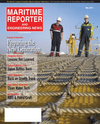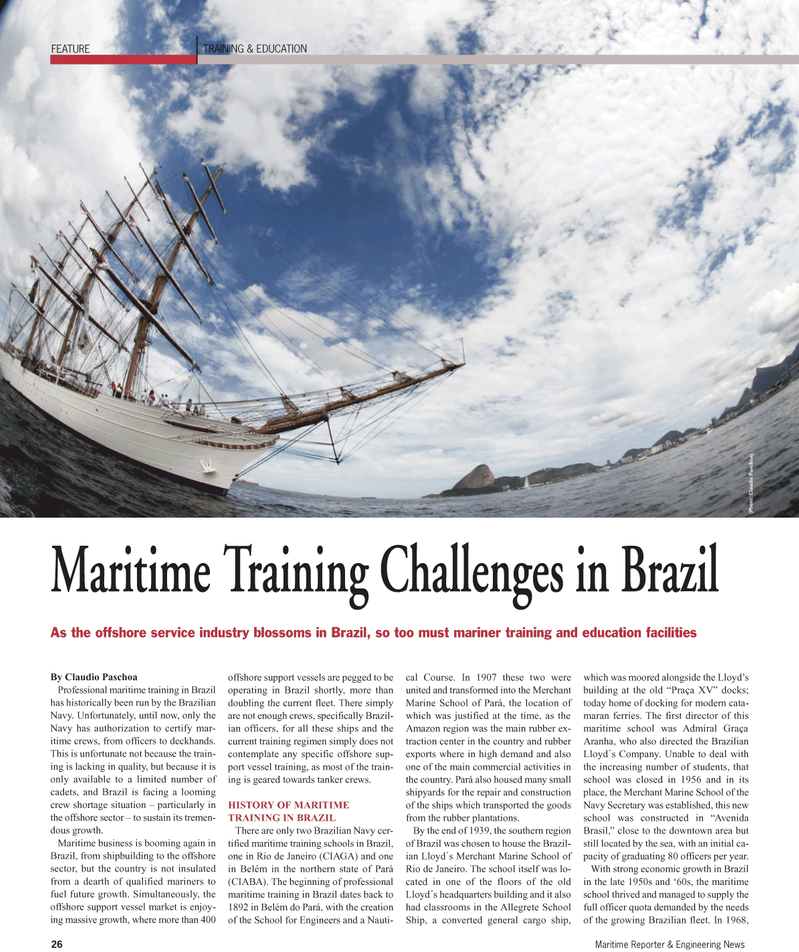
Page 26: of Maritime Reporter Magazine (May 2011)
Training & Education Edition
Read this page in Pdf, Flash or Html5 edition of May 2011 Maritime Reporter Magazine
By Claudio Paschoa
Professional maritime training in Brazil has historically been run by the Brazilian
Navy. Unfortunately, until now, only the
Navy has authorization to certify mar- itime crews, from officers to deckhands.
This is unfortunate not because the train- ing is lacking in quality, but because it is only available to a limited number of cadets, and Brazil is facing a looming crew shortage situation – particularly in the offshore sector – to sustain its tremen- dous growth.
Maritime business is booming again in
Brazil, from shipbuilding to the offshore sector, but the country is not insulated from a dearth of qualified mariners to fuel future growth. Simultaneously, the offshore support vessel market is enjoy- ing massive growth, where more than 400 offshore support vessels are pegged to be operating in Brazil shortly, more than doubling the current fleet. There simply are not enough crews, specifically Brazil- ian officers, for all these ships and the current training regimen simply does not contemplate any specific offshore sup- port vessel training, as most of the train- ing is geared towards tanker crews.
HISTORY OF MARITIME
TRAINING IN BRAZIL
There are only two Brazilian Navy cer- tified maritime training schools in Brazil, one in Rio de Janeiro (CIAGA) and one in Belém in the northern state of Pará (CIABA). The beginning of professional maritime training in Brazil dates back to 1892 in Belém do Pará, with the creation of the School for Engineers and a Nauti- cal Course. In 1907 these two were united and transformed into the Merchant
Marine School of Pará, the location of which was justified at the time, as the
Amazon region was the main rubber ex- traction center in the country and rubber exports where in high demand and also one of the main commercial activities in the country. Pará also housed many small shipyards for the repair and construction of the ships which transported the goods from the rubber plantations.
By the end of 1939, the southern region of Brazil was chosen to house the Brazil- ian Lloyd´s Merchant Marine School of
Rio de Janeiro. The school itself was lo- cated in one of the floors of the old
Lloyd´s headquarters building and it also had classrooms in the Allegrete School
Ship, a converted general cargo ship, which was moored alongside the Lloyd’s building at the old “Praça XV” docks; today home of docking for modern cata- maran ferries. The first director of this maritime school was Admiral Graça
Aranha, who also directed the Brazilian
Lloyd´s Company. Unable to deal with the increasing number of students, that school was closed in 1956 and in its place, the Merchant Marine School of the
Navy Secretary was established, this new school was constructed in “Avenida
Brasil,” close to the downtown area but still located by the sea, with an initial ca- pacity of graduating 80 officers per year.
With strong economic growth in Brazil in the late 1950s and ‘60s, the maritime school thrived and managed to supply the full officer quota demanded by the needs of the growing Brazilian fleet. In 1968, 26 Maritime Reporter & Engineering News
FEATURE TRAINING & EDUCATION
Maritime Training Challenges in Brazil
As the offshore service industry blossoms in Brazil, so too must mariner training and education facilities (Photo: Claudio Paschoa)

 25
25

 27
27
